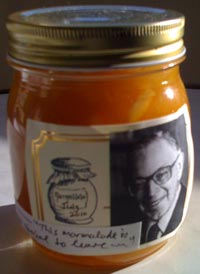No win, lots of fees – remembering Copper 7 … Law and Social Work get cognate at U.Syd … Judge Felicity – feisty telly star … Wendler’s marmalade – by appointment ...
 I’m grateful that an eagle-eyed silk has passed-on an important but neglected observation from Bergin J, as she was, CJ in Eq as she now is.
I’m grateful that an eagle-eyed silk has passed-on an important but neglected observation from Bergin J, as she was, CJ in Eq as she now is.
Her judgment in Wings-Aus Holdings Pty Ltd trading as Hooters Restaurants Aust and NZ commenced descriptively:
“Establishments known as ‘Hooters’, casual beach-themed restaurants, have been operating throughout the world since 1983 …”
I wonder whether her Hon accurately captured the theme of this charming chain of wholesome eateries.
* * *
Talking of Paddy Bergin, her recent judgment in Spence v Gerard Malouf & Partners was a corker.
Allan Spence sought an order that Gerard Malouf release his file to his new solicitors. He got what he wanted and costs.
Malouf had been acting on a no win, no fees basis in a case where Spence was suing another firm of solicitors for professional negligence.
Malouf stopped acting for Spence after the plaintiff rejected a settlement offer of $100,000, which he regarded as objectionably low. Malouf clung onto the file claiming fees of $240,000 were owing.
However, Bergin made some hurtful remarks about the no win, no fee caper.
“In a no win, no charge, retainer, when solicitors livlihoods and incomes are bound up with, and dependant upon, the client taking a particular step in litigation, it seems to me that the capacity to provide the client with objective advice about taking that step is compromised. The greater the amount of fees to be lost, the greater the prospect of compromise.”
 Cashman: Copper 7 chaosIt all came hurtling back to your correspondent.
Cashman: Copper 7 chaosIt all came hurtling back to your correspondent.
Years ago Little Peter Cash-Man raced to the NSW Spigeltent to get an injunction to restrain Justinian’s further publication of the settlement details offered to his clients in the disastrous Copper 7 “class action”.
Three hundred women had sued over infections, organ damage and infertility caused by the Gravigard IUD.
The settlement arrangement was supposed to be confidential but your organ had reproduced substantial parts of it.
The deal was that the non-lead plaintiffs were to get $1,000 each and the nine lead plaintiffs $111,111 each.
That was a total of $1.3 million which was to come out of $7 million the defendant company was to pay to Maurice Blackburn Cashman.
That is: $5.7 million to the lawyers, $1.3 million to the damaged punters.
This was a “win”, after 14 years of litigation and major stuff-ups and delays by the trial judge, Vince Bruce.
Immediately after he gave judgment Bruce resigned from the Supreme Court citing attacks from the media.
The plaintiffs were strenuously reminded that under the retainer agreement if they did not settle they would be up for at least $15,000 each in legal expenses and disbursements, which totalled $4.5 million and was payable, win or lose.
Cashman said that amount would be waived if the clients signed the settlement agreement. They had no option but surrender.
The difficulty for Cash-Man’s injunction application was that Justinian’s editor R. Ackland had that evening also written a story for The Sydney Morning Herald based on the same material.
As Justice John Hamilton said the next day after reading the Herald:
“The vast bulk of the horse has bolted.”
He did injunct from further publication Terry Tobin QC’s advice, which got a run in Justinian but not the SMH.
As Bergin put it nine years after the Copper 7 disaster:
“If the case is technically ‘won’ but costs are significant, the win may be pyrrhic.”
Cash-Man recently designed the civil litigation reforms for Victoria and is now Prof Cashman at USydney law school.
* * *
 Rev. Spence: "cognate communities"For those interested in the future of the University of Sydney law faculty there is no more transfixing document than Rev. Michael Spence’s Consultation Phase Two: Structures and Governance.
Rev. Spence: "cognate communities"For those interested in the future of the University of Sydney law faculty there is no more transfixing document than Rev. Michael Spence’s Consultation Phase Two: Structures and Governance.
Rev. Spence is the Vice Chancellor and has been pushing for the creation of super divisions, into which “cognate academic communities” are to be brought together for purposes of “joint planning and mutual accountability”.
The law faculty has been lined-up to fuse with the faculties of Economics & Business and Education & Social Work under the umbrella Division of Business Law and Education.
Law and Social Work. What a delightful juxtaposition.
It is all too ghastly and deans Gillian Triggs (Law) and Peter Wolnizer (Econ & Biz) have objected in strong terms about the proposals contained in the strategy Green Paper.
The VC is not impressed. As he puts it in his “consultation” paper:
“A consistent concern has been expressed about the place of law in the proposed structure, with the arguments of the Green Paper for its exclusion from a wider group finding little support outside the faculty itself.”
He attached some interesting stats to his management babble, which showed Sydney Uni law school has 1,731 students (4.4 percent of the uni’s student population), staff of 119 (2.6 percent of USyd’s staff), it generates 0.3 percent of the university’s gross research grant revenue and 3.8 percent of the university’s gross learning and teaching revenue.
By contrast, medicine is the most “profitable” faculty generating 48 percent of the uni’s gross research grant revenue and 15 percent of the learning and teaching revenue.
Under the “cognate” plans medicine is to be bundled with nursing, dentistry and pharmacy to form the Division of Medicine and Health.
Will the indignities ever cease?
* * *
 Judge Hampel: fended off Pigs ArseI thought it was pretty fabulous to see Judge Felicity Hampel from the Vic County Court bob-up on the ABC’s Q & A – putting in a strong argument for a humane asylum seeker policy.
Judge Hampel: fended off Pigs ArseI thought it was pretty fabulous to see Judge Felicity Hampel from the Vic County Court bob-up on the ABC’s Q & A – putting in a strong argument for a humane asylum seeker policy.
“I think it’s shameful that there is a rhetoric of fear and hysteria about refugees and asylum seekers,” she told the viewers.
And she made it clear that both sides of politics were culpable.
Fellow panelists included John (Pigs Arse) Elliott, whom whom she agreed about on-shore processing, and the execrable Christopher Pyne (Lib, SA).
At one point Pigs Arse tried to put his arm around the judge – greatly to her consternation.
Pyne invariably makes any TV show on which he appears unwatchable, but Judge Felicity kept me glued.
Here was a good example of an articulate judge sticking her neck out on a public issue. Viscount Kilmuir was nowhere in sight.
Why can’t we have more of it?
* * *
 Gabriel Wendler is a highly regarded Sydney crim barrister and Justinian’s wine correspondent.
Gabriel Wendler is a highly regarded Sydney crim barrister and Justinian’s wine correspondent.
He is also an award winning marmalade maker with Seville oranges supplied from the extensive family orchards of fellow brief Cameron Jackson.
The preserve is in high demand among cognoscenti of the bitter-sweet topping.
One of its devoted admirers is former High Court CJ, Sir Anthony Mason.
It is understood he cannot start his day without a good dollop of Wendler’s finest.
So much so, that Sir Anthony has agreed to provide his warrant of appointment to the merchandise.
His beaming visage now adorns the label with the caption: “This marmalade is too special to leave.”